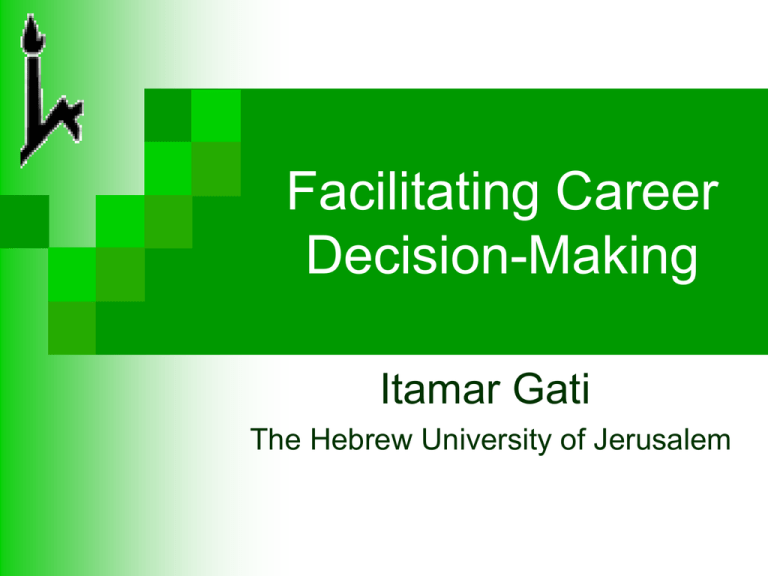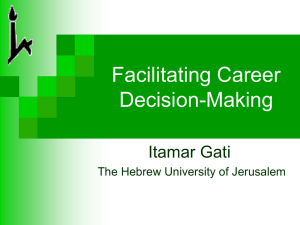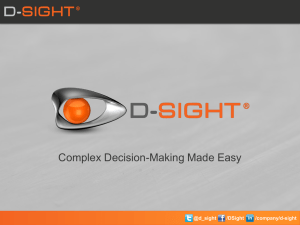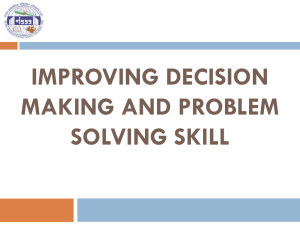Facilitating Career Decision-Making
advertisement

Facilitating Career Decision-Making Itamar Gati The Hebrew University of Jerusalem In this presentation, I will Discuss the decision-theory viewpoint Present the PIC 3-stage cdm model Introduce the CDDQ Describe the CDSQ – cdm style Demonstrate MBCD - Making Better Career Decisions Review research and demonstrate applications Highlight the unique features of our approach 2 Unique features of career decisions Quantity of Information: Often large N of alternatives and factors, within-occupation variance information is practically unlimited Quality of Information: soft, subjective, fuzzy, inaccurate, biased Uncertainty about: the individual’s future preferences, future career options, unpredictable changes and opportunities, probability of implementing choice Non-cognitive Factors: emotional and personality-related factors, necessity for compromise, actual or perceived social barriers and biases 3 From decision theory to career counseling practice Many factors contribute to the complexity and difficulties involved in career decision-making The basic claim: Career counseling may be viewed as decision counseling, which aims at facilitating the clients' decision-making process, and promotes better career decisions 4 If so evident, why was decisiontheory not adopted until recently? Because Normative decision theory (how individuals should make decisions) is – too rational too arbitrary too quantitative exceeds human’s information-processing capability Descriptive decision theory (how individuals actually make decisions) is not helpful either – it mainly documents human weakness heuristics, biases, and fallacies limited information-processing capabilities 5 The Proposed Approach – By adopting decision theory and adapting it to the unique features of career decisions, theoretical knowledge can be translated into practical interventions to facilitate individuals’ career choices Specifically, we suggest focusing on a prescriptive approach, and designing systematic procedures that can help individuals make better career decisions (not necessarily rational ones!) 6 The first stage in helping clients is needs assessment: The 3 components of needs assessment are: the individual’s stage in the cdm process (“where”) the focuses of the individual’s cdm difficulties (“what”) the individual’s cdm style (“who”) 7 I- Stages in the career decision-making process The PIC model (Gati & Asher, 2001) separates the career decision-making process into 3 distinct stages: - Prescreening - In-depth exploration - Choice 8 Prescreening Goal: Locating a small set (about 7) of promising alternatives that deserve further, in-depth exploration Method: Sequential Elimination Locate and prioritize relevant aspects or factors Explicate within-aspect preferences Eliminate incompatible alternatives Check list of promising alternatives Outcome: A list of verified promising alternatives worth further, in-depth exploration 9 A Schematic Presentation of the Sequential Elimination Process (within-aspects, across-alternatives) Potential Alternatives Aspects a b 1 2 3 4 . . . . N (most important) (second in importance) c . n Promising Alternatives 10 Final step - Sensitivity Analysis The Goal: Verifying the adequacy of the promising list The Method: An alternative (compensatory-model-based) search “why not” “almost compatible” “what if” “similar alternatives” 11 In-depth exploration Goal: Locating alternatives that are not only promising but indeed suitable for the individual Method: collecting additional information, focusing on one promising alternative at a time: Is the occupation INDEED suitable for me? verifying compatibility with one’s preferences in the most important aspects considering compatibility within the less important aspects Am I suitable for the occupation? probability of actualization: previous studies, grades, achievements fit with the core aspects of the occupation Outcome: A few most suitable alternatives (about 3-4) 12 A Schematic Presentation of the In-depth Exploration Stage (within-alternative, across aspects) Promising Alternatives 1 2 2 3 4 5 4 5 6 Suitable Alternatives 13 Choice Goal: Choosing the most suitable alternative, and rankordering additional, second-best alternatives Method: comparing and evaluating the suitable alternatives pinpointing the most suitable one Am I likely to activate it? if not - selecting second-best alternative(s) if yes - Am I confident in my choice? if not: Return to In-depth exploration stage if yes: Done! Outcome: The best alternative or a rank-order of the best alternatives 14 II Career Decision-Making Difficulties One of the first steps in helping individuals make a career decision is locating the focuses of the difficulties they face in the decision-making process Relying on decision theory, Gati, Krausz, and Osipow (1996) proposed a taxonomy for describing career decision-making difficulties 15 Possible Focuses of Career Decision-Making Difficulties (Gati, Krausz, & Osipow, 1996) During the Process Prior to Engaging in the Process Lack of Readiness due to Lack of Indecimotivation siveness Lack of Information about Dysfunc- Cdm Self Occupations tional process beliefs Ways of obtaining info. Inconsistent Information due to Unreliable Internal Info. conflicts External conflicts 16 The Career Decision-making Difficulties Questionnaire (CDDQ) The Career Decision-making Difficulties Questionnaire (CDDQ) was developed to test this taxonomy and serve as a means for assessing individuals’ career decision-making difficulties Cronbach Alpha internal consistency estimate of the total CDDQ score is high (above .90) The proposed structure was empirically supported (N=10,000) For additional information – see www.cddq.org --- the CDDQ is offered free of charge --17 www.cddq.org 18 19 20 The Four Stages of Interpretation 1. Ascertaining Credibility, using validity items and the time required to fill out the questionnaire 2. Estimating Differentiation based on the standard deviation of the 10 difficulty-scale scores 3. Locating the salient, moderate, or negligible difficulties, based on the individual's absolute and relative scale scores 4. Determining the confidence in the feedback and the need to add reservations to it (based on doubtful credibility, partial differentiation, or low informativeness) 21 The 4 Stages of Interpretation 1 Doubtful 2 Credible Estimating Differentiation Questionable 3 Aggregate Reasons to Add Reservation (RAR) B/W < 1 RAR = 3 RAR ≤ 2 4 Add Reservation to Feedback Not Credible Evaluating Credibility Low High Locate Salient Difficulties Compute Informativeness (B /W ) B/W > 1 Receives Feedback No Feedback 22 Four Studies for validating the proposed interpretation Method Participants: 15-30 career counselors and 25-80 graduate counseling students Questionnaires – including CDDQ responses: - in Study 1 and 4 – all possible responses; - in Studies 2 and 3 – responses of 16 actual clients Results: High similarity within-groups as well as between counselors’ and students’ judgments High similarity between the experts’ judgments and the proposed algorithm at each stage 23 The distribution of types of feedback in the four groups 100% 90% 80% feedback add reservation 70% 60% 50% no feedback 40% 30% 20% 10% 0% P&P Internet Hebrew P&P Internet English 24 Conclusions The incorporation of an intermediate level of discrimination increases the usefulness of the feedback and decreases the chances and implications of potential errors Adding reservations when appropriate is essential for providing a meaningful feedback and decreasing the chances of misleading conclusions 25 III – Career Decision-Making Styles Diagnosing the client’s career decision-making style is important in order to “tailor” the careercounseling intervention to his or her unique characteristics Previous research often did not take into consideration the complexity and variety of aspects related to the decision process, and classified decision-styles based only on a single, most dominant characteristic (e.g., rational vs. intuitive) 26 Goals Developing a multidimensional model for describing career decision-making styles Developing the Career Decision-making Styles Questionnaire (CDSQ) for testing the model and enabling a more accurate assessment of individuals’ career decision-making styles Empirically deriving a typology of the CDSQ profiles from a large sample of individuals 27 Derivation of the 11 Dimensions Comparing the most common 12 prototypes deduced from previous research to uncover the various characteristics differentiating among them From this list we derived 11 basic dimensions relevant for characterizing individuals' cdm styles. On each dimension, individuals can be characterized along a continuum of a bipolar scale: e.g., on the dimension pattern of information processing individuals can be characterized from "analytical" to "holistic"; desire to please others – "high" to "low" 28 The 11 Proposed Dimensions Information processing (analytic vs. holistic) Information gathering (much vs. little) Amount of effort invested in the process (much vs. little) Consultation with others (frequent vs. rare) Aspiration for an "ideal occupation" (high vs. low) Willingness to compromise (high vs. low) Locus of control (internal vs. external) Procrastination in entering the process (high vs. low) Speed of making the final decision (fast vs. slow) Dependence on others (high vs. low) Desire to please others (high vs. low) 29 The Career-Decision-making Style Questionnaire (CDSQ) 44 statements (4 items x 11 dimensions) Response scale: 1 – Strongly disagree to 7 – Strongly agree The CDSQ is embedded in career-related selfhelp Internet sites Future Directions (Hebrew), CDDQ.ORG (English) 3 Development samples (N=230, 404, 411) Fourth sample - 479 subjects 30 Results – (Items) Scale Reliabilities: median - .80, range .73 – .85 Factor analysis: 10 factors Accounted-for Variance = .65 2 dimensions were included in one factor (Speed of making the final decision; Procrastination) Two items loaded higher on a “neighbor factor” (Informationprocessing; effort invested) Cluster analysis: Accounted-for Variance = .81 Items of 7 dimension clustered perfectly (4/4) 4 dimension – 3/4 items 31 Conclusions & Implications The proposed and tested 11 dimensions can be used to characterize individuals' career decisionmaking styles Using the CDSQ, homogeneous groups of clients with similar career decision-making styles can be empirically identified The CDSQ allows a more accurate assessment of the counselees' career decision-making styles, thus better “tailoring” the intervention to the individual The CDSQ allows individuals to learn about their career decision-making style, and thus to consider adopting more desirable strategies 32 So far, I reviewed 3 components of client’s needs assessment: The individual’s stage in the cdm process (“Where”) The focuses of the individual’s cdm difficulties (“What”) The individual’s cdm style (“Who”) So, what’s next? Some demonstrations of how can the decision-making approach be implemented in order to actually facilitate clients’ cdm 33 Specifically, if career decision-making requires collecting a vast amount of information, and if complex information-processing is needed, we must then utilize the best available resource: Career counselors’ expert knowledge, that can be elicited and transformed into Information and Communication Technology-based systems Indeed, - The computer-assisted career guidance systems, based on a decision-theory model, can help overcome human’s cognitive limitations - There are several computer-assisted career guidance systems available today on the Internet 34 MBCD Making Better Career Decisions MBCD is an Internet-based career planning system that is a unique combination of a career-information system a decision-making support system an expert system Based on the rationale of the PIC model, MBCD is designed to help deliberating individuals make better career decisions 35 Making Better Career Decisions http://mbcd.intocareers.org 36 37 38 39 40 41 However, Although Internet-based, career-related self-help sites are flourishing, these sites vary greatly in quality Therefore, it is very important to investigate the utility and validity of these self-help programs 42 So, Making Better Career Decisions Does it really work? 43 Criteria for Testing the Benefits of Making Better Career Decisions • Examine users' perceptions of MBCD • Examine changes in user’s decision status • Examine perceived benefits • Locate factors that contribute to these variables 44 MBCD’s Effect (Cohen’s d) on Reducing Career Decision-Making Difficulties (Gati, Saka, & Krausz, 2003) 0.8 0.72 0.65 d 0.7 0.6 0.5 0.4 0.31 0.3 0.2 0.11 0.1 0 Lack of Readiness Lack of Information Inconsistent Information Total CDDQ 45 Decision Status Before and After the “Dialogue” with MBCD Before the dialogue After the dialogue 1 2 3 4 5 1- no direction 34 7 6 7 0 2 - only a general direction 41 66 15 9 5 3 - considering a few specific alternatives 27 58 84 30 6 4 - would like to examine additional alternatives 23 51 35 54 6 5 - would like to collect information about a specific occupation 646- sure which occupation to choose 9 20 21 41 28 3 0 1 9 16 Perceived Suitability of the "Promising Alternatives" List (N=693) 100% 90% too long 80% 70% 60% 50% suitable 40% 30% too short 20% 10% 0% 2 3-4 5 6 7 8-10 11-15 16-25 26+ (n=23) (n=74) (n=71) (n=121) (n=236) (n=45) (n=40) (n=46) (n=37) Number of Alternatives (n - of users) 47 Predictive Validity of MBCD (Gati, Gadassi, & Shemesh, 2006) Design: Comparing the Occupational Choice Satisfaction (OCS) of two groups six years after using MBCD and getting a list of occupations recommended for further exploration: those whose present occupation was included in MBCD’s recommended list (44%) those whose present occupation was not included in MBCD’s recommended list (56%) 48 Method Participants The original sample included 123 clients who used MBCD in 1997, as part of their counseling at the Hadassah Career-Counseling Institute Out of the 73 that were located after six+ years, 70 agreed to participate in the follow-up: 44 women (64%) and 26 men (36%), aged 23 to 51 (mean = 28.4, SD = 5.03) 49 Frequencies of Occupational Choice Satisfaction by “Acceptance” and “Rejection” of MBCD's Recommendations (Gati, Gadassi, & Shemesh, 2006) 100% 90% 80% 70% 60% 50% 40% 30% 20% 10% 0% 16% 18% low satisfaction 44% medium satisfaction high satisfaction 84% 38% accepted did not accept recommendations recommendations 50 Gender Differences in Directly Elicited and Indirectly Derived Preferred Occupations (279 Women + 79 Men, Mean Age=23; Gadassi & Gati, 2008) Means of the Gender Dominance Ratings According to Type-of-List and Gender 3.18 3.13 2.96 Men Women 2.71 Indirectly Derived 3.3 3.2 3.1 3 2.9 2.8 2.7 2.6 2.5 2.4 Directly Elicited 51 Summary of Major Findings PIC is compatible with people’s intuitive ways of making decisions (Gati & Tikotzki, 1989) Most users report progress in the career decisionmaking process (Gati, Kleiman, Saka, & Zakai, 2003) Satisfaction was also reported among those who did not progress in the process Users are “goal-directed” – the closer they are to making a decision, the more satisfied they are with MBCD The list of “recommended” occupations are less influenced by gender stereotypes (Gadassi & Gati, 2008) 52 In Conclusion – Features of our Approach Prescreening is essential when the number of potential alternatives is large Instead of focusing on occupations (alternatives) we suggest to focus on aspects Instead of a “snap-shot” assessments of vocational interests (e.g., the 3-highest RIASEC Holland’s code), use for prescreening a wide range of factors elicited by a dynamic, interactive process 53 In Conclusion – Features of our Approach (cont.) From the viewpoint of the individual, this enables: - Differentiating between relative importance of factors, the optimal level, and the willingness to compromise - Assessing the individual’s preference crystallization (does s/he knows what s/he is looking for?) With respect to occupations, this enables: - Characterizing occupations in terms of a range of levels, representing the within-occupation variance - Highlighting the essence of the occupation (using the core aspects) 54 We believe that . . . Computers can and should be used not only for scoring, but also for monitoring a dynamic interaction, and providing flexible interpretations Experts’ knowledge can and should be elicited and transformed to design and improve interpretive feedbacks on assessments Career choices are the outcome of decision-making processes; therefore, career counseling is, in fact, decision counseling The goal should be promoting a systematic decision making process – not a rational one 55 Finally, we also believe that . . . Career-related assessments can be transformed into user-friendly Internet-based systems, which can also be incorporated into counseling interventions Interpretive feedback is important but has to be “tailored” and validated Theory-based interventions should always be tested for empirically validity as well as practical effectiveness 56 www.cddq.org itamar.gati@huji.ac.il 57 end -- 58 ------sfsfsf------------ 59 Previous Research 1. 39 labels used for describing decisionmaking styles were located 2. In light of the high resemblance among some of them (e.g., logical [Arroba, 1977], rational [Harren, 1979], active-planning [Jepsen, 1974], systematic [Johnson, 1978]), these 39 types were narrowed down to 12 prototypes : rational, perfectionist, procrastinator, searching for tools, satisfying, hesitant, impulsive, fatalist, intuitive, dependent, rebellious, and pleasing. 60 Alternative Explanations [to MH] – were not supported Differences in the lengths of the lists No difference was found in the OCS between clients whose list included 15 or fewer occupations and clients whose list included more than 15 occupations Clients who accepted MBCD’s recommendations are more compliant, and therefore more inclined to report a high level of satisfaction However, following the compensatory-model-based recommendations did not contribute to the OCS 61 Results - Typology Group G1 G2 G3 G4 G5 G6 G7 DIMENSION n=38 n=77 n=79 n=65 n=47 n=87 n=64 Information-processing 3.65 4.91 4.76 5.17 3.45 5.35 5.09 Information gathering 3.94 5.21 5.34 5.83 3.43 5.94 5.79 Amount of effort invested 4.82 6.06 6.05 5.41 4.62 6.32 5.72 Consultation with others 5.64 5.58 6.26 4.02 5.33 5.64 5.83 "ideal occupation" 4.12 2.01 3.12 2.25 3.39 2.56 2.14 Willingness to compromise 3.08 4.81 4.91 3.33 5.12 3.60 3.03 Locus of control 5.59 5.24 4.91 6.10 5.26 5.61 5.58 Speed of making decision 3.73 3.24 2.25 5.42 3.02 2.47 4.38 Procrastination 4.21 5.10 2.66 5.78 2.58 3.53 4.97 Dependence 6.16 5.60 3.89 6.47 5.76 6.19 6.40 Desire to please others 5.88 4.72 4.26 5.69 5.79 5.94 5.99 62 Steps in Sequential Elimination Locating and prioritizing aspects or factors Explicating within-factor preferences in the most important factor not yet considered Eliminating incompatible alternatives Too many promising alternatives? yes no This is the recommended list of occupations worth further, in-depth exploration 63






